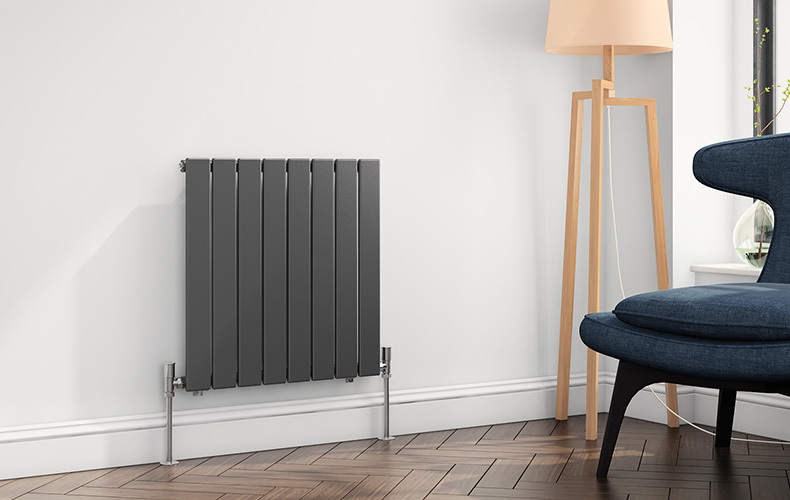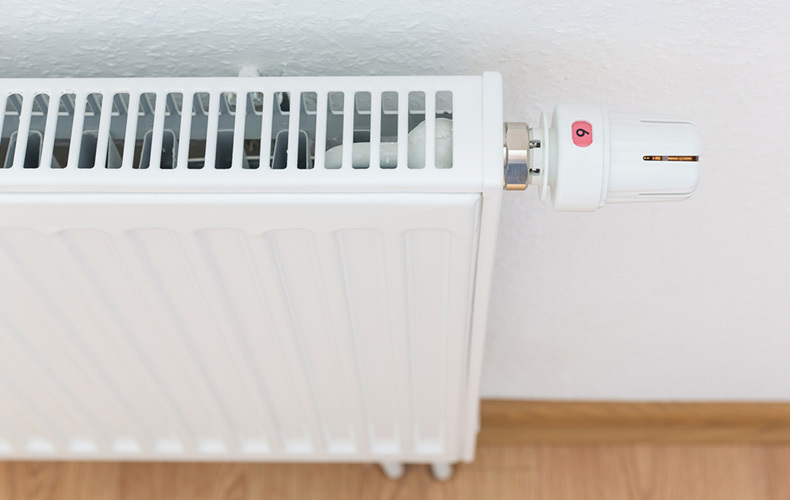Convector radiators are any radiator that is built to focus on convection heat rather than simply letting the heat radiate outwards. This is achieved by 'sandwiching' layers of fins between panels in various arrangements. If you're thinking of buying a convector radiator, this article will explain all you need to know.
Flat Panel Radiators: The Beginning
Every radiator is essentially a hollow conductive tank that's fed water from one side and drains from the other side. Once you click your central heating on, they heat up from the inside and radiate that heat outwards into your home.
Flat-panel radiators, are your basic rectangular metal tank and are likely a couple inches thick and a metre or so in length. They're skinny, hence the 'flat' name, and are the simplest form a modern radiator can take - from which all other radiator designs build upon. They still use convection to heat, however they're not strictly convection radiators. Flat panel radiators are a popular, slimline solution to heating a room. So if you're after something slim, maybe consider a flat panel.

Convector Radiators: Basically Flat Panels with Fins
The main difference between a flat panel radiator and convector radiator is the added bonus of a layer of metal radiator fins that are all heated evenly to produce more heat.
By bolting a zig-zag layer of metal fins behind the radiator, it creates a considerable amount of surface area to your metal tank which means that more heat is pulled away from the radiator by air currents. This happens through convection heating.

What is Convection Heating?
Since gaps between the radiator fins are purposely vertical, and this cleverly-compact-yet-wide surface area is contained between the wall and the panel(s) of your radiator, this means heat can only travel upwards, with the cold air that's fallen to the bottom of the room being drawn up into the bottom of the radiator - air currents created by nothing more than airflow caused by heat rising.
All Radiators Convect, but not all Radiators Are Convection Radiators
All radiators heat the cool air at the bottom of the room, which rises upwards as heat to create a constant, rotating flow of cool air going in and warm air coming out. But, not all radiators are called 'convector radiators'. That's because radiators just let convection happen, whereas convection radiators encourage it.
Convection Radiators vs Radiators
All radiators heat using convection, and they also 'radiate' that heat sideways. Which is fine. Convector radiators do that too. And if you like to sit right next to the radiator then you'll feel the benefit. But, it's less effective for evenly heating larger rooms. Convection radiators use their sandwich-shape design to better funnel rising air as it heats it, constantly channelling it upwards to keep a constant rotation going.
Put as simply as possible: convector radiators spread their heat better across larger spaces.
What are the Different Types of Convector Radiator?
Note: The below list of convector types assumes a similar width and height throughout. Because obviously, in theory, a single panel convector radiator the size of the entire wall would heat better than a double panel the size of an A4 piece of paper, but we're keeping the width and height the same, and simply changing the amount of panels, convector fins, and overall depth.
Single Panel Convector Radiators (Type 11) Explained
The single panel convector radiator, AKA a 'K1' or 'Type 11' radiator. Not to be confused with a regular 'single panel radiator Type 10 radiator' because this is a single panel radiator with convector fins bolted to the back. The appeal of the single panel is the fact that it provides far more BTU output than a similarly sized normal radiator. It's also thicker than a normal radiator, but the thicker profile is a nice trade-off for the BTU increase.
If you're looking to heat a relatively small room quickly then they're ideal. You can also get them in fairly long sizes too, making them a good choice for hallways and corridors to strike a balance between size and heat output.
Double Panel Plus Convector Radiators (Type 21) Explained
The double panel plus convector radiator, AKA a 'P+' or 'Type 21' radiator. It's literally a single panel radiator with a second panel added at the back; sandwiching the single layer of convector fins between the two panels. Though the fins are only directly connected to a single panel. This results in a much thicker radiator than the single panel counterpart, but of course the BTU is increased substantially.
This configuration of convector radiator is still relatively slim, and can comfortably fit in even small rooms.
Double Panel Convection Radiators (Type 22) Explained
The double panel convector radiator, AKA the 'K2' or 'Type 22' radiator. Two layers of convector fins sandwiched between two single panels. Each panel has its own set of fins for a whole lot of surface area and a whole lot of heat.
Ideal for heating medium to large rooms. They're generally quite thick, but relative to the heat output they provide they're saving you a lot of room in terms of width and height.
Double-Panel Double Convection Radiators (Type 33) Explained
Double panel double convection radiators. 3 layers of convective fins mounted between 3 radiator panels. It's essentially a double panel convection radiator with a single panel Type 11 added to it. If you've been paying attention you know all about this radiator already. It's far thicker than your usual radiator, and it's far, far more powerful.
How to Choose the Best Convector Radiator
If you're wanting to opt for a convector radiator but aren't sure which one to go for, take a look at our guide on how to choose the perfect radiator. Similarly, if you've chosen a radiator but aren't sure what heat output you need, our handy BTU calculator will help you to find the right choice.








